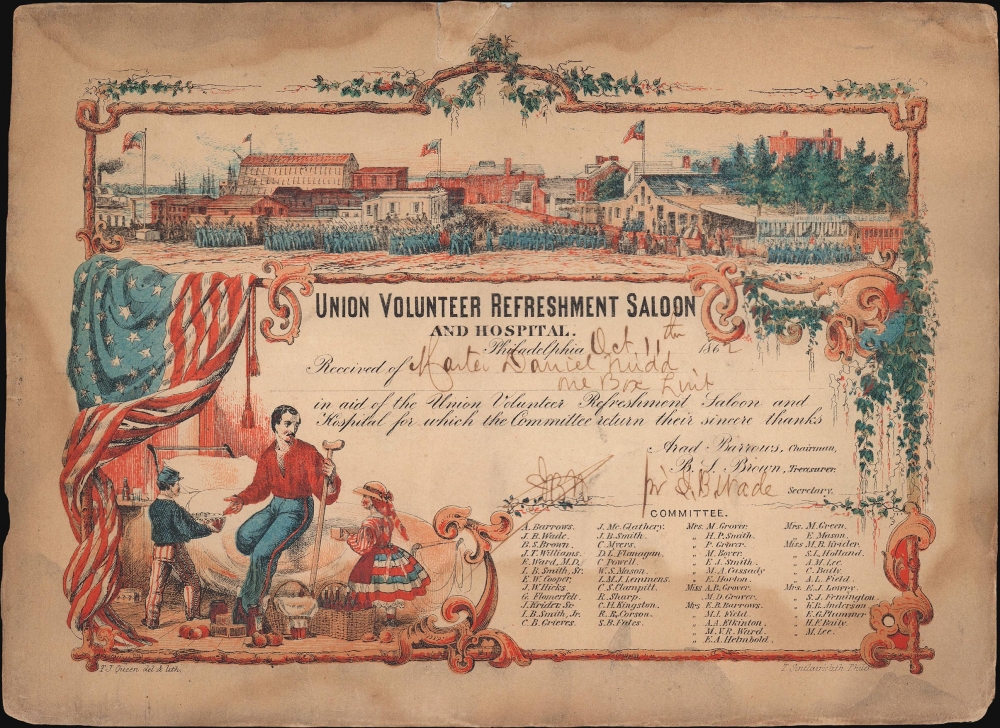Digital Image: 1861 J. F. Queen Union Volunteer Refreshment Saloon Donation Certificate
UnionSaloonDonation-queen-1861_d
Title
1861 (undated) 5.25 x 7.25 in (13.335 x 18.415 cm)
Description
FOR THE ORIGINAL ANTIQUE MAP, WITH HISTORICAL ANALYSIS, CLICK HERE.
Digital Map Information
Geographicus maintains an archive of high-resolution rare map scans. We scan our maps at 300 DPI or higher, with newer images being 600 DPI, (either TIFF or JPEG, depending on when the scan was done) which is most cases in suitable for enlargement and printing.
Delivery
Once you purchase our digital scan service, you will receive a download link via email - usually within seconds. Digital orders are delivered as ZIP files, an industry standard file compression protocol that any computer should be able to unpack. Some of our files are very large, and can take some time to download. Most files are saved into your computer's 'Downloads' folder. All delivery is electronic. No physical product is shipped.
Credit and Scope of Use
You can use your digial image any way you want! Our digital images are unrestricted by copyright and can be used, modified, and published freely. The textual description that accompanies the original antique map is not included in the sale of digital images and remains protected by copyright. That said, we put significant care and effort into scanning and editing these maps, and we’d appreciate a credit when possible. Should you wish to credit us, please use the following credit line:
Courtesy of Geographicus Rare Antique Maps (https://www.geographicus.com).
How Large Can I Print?
In general, at 300 DPI, you should at least be able to double the size of the actual image, more so with our 600 DPI images. So, if the original was 10 x 12 inches, you can print at 20 x 24 inches, without quality loss. If your display requirements can accommodate some loss in image quality, you can make it even larger. That being said, no quality of scan will allow you to blow up at 10 x 12 inch map to wall size without significant quality loss. For more information, it is best consult a printer or reprographics specialist.
Refunds
If the high resolution image you ordered is unavailable, we will fully refund your purchase. Otherwise, digital images scans are a service, not a tangible product, and cannot be returned or refunded once the download link is used.
Cartographer S
James Fuller Queen (1820/21 - January 15, 1886) was a Philadelphia-based lithographer, chromolithographer, and artist, and is remembered for his composition and attention to detail. Born in Philadelphia in 1820 or 1821, Queen's lithography career began after he became an apprentice to George Lehman and P S. Duval on November 24, 1835. Queen spent the next 5 years as Duval's apprentice and remained associated with him for the rest of his career. Queen also worked with Wagner and McGuigan, Duval's major business rival, during the mid-1840s, but most of his output was published by Duval. In 1861, Queen became the superintendent of the drawing department at the Duval firm. Queen continued working for Duval during the American Civil War (1861 - 1865) despite enlisting in the Pennsylvania Militia during the summers of 1862 and 1863, and Queen produced some of his best work during the Civil War years. He identified himself as a chromolithographer by the 1870s and worked into the early 1880s. He died of multiple sclerosis on January 15, 1886. Queen married Sarah Harvey in 1843 with whom he had three daughters. More by this mapmaker...
Thomas S. Sinclair (c. 1805 - 1881) was an American lithographer. Born in the Orkney Islands, Scotland, Sinclair studied lithography in Edinburgh and other European cities before moving to the United States sometime before 1833. He was established in Philadelphia by 1833, when he drew a dancing scene for the firm of Kennedy and Lucas, which went out of business that same year. In 1838, Sinclair acquired the press of John Collins and opened his own lithography firm. He was among the first lithographers in Philadelphia to experiment with color lithography, beginning in 1843. By 1848, his skills ad advanced to such a degree that he won a silver medal for color lithography at the Franklin Institute's exhibition. Sinclair's brother, William B. Sinclair, joined the firm in 1854, and from that year until 1859 the establishment was known as Thomas Sinclair and Company. His son joined the company at one point also, and then the firm's name changed to Thomas Sinclair and Son. Sinclair died in Philadelphia in 1881. Learn More...

